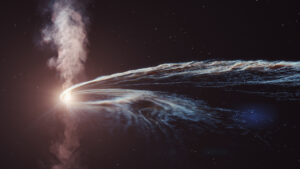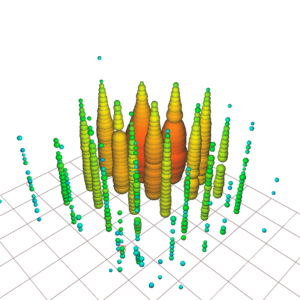15 March 2021 – In the past weeks, not one but two exciting observations were published in the field of neutrino-astronomy! A neutrino was observed that could be correlated to a Tidal Disruption Event observed by the Zwicky Transient Facility and for the first time a particle shower was observed by the IceCube detector at the energy of the Glashow resonance. KM3NeT rejoices for these remarkable observations that show the increasing power of neutrino astronomy and multi-messenger observation.
A high-energy neutrino detected in the direction of a Tidal Disruption Event
The IceCube Neutrino Observatory constantly monitors the sky, searching for high-energy neutrinos emitted from the most energetic phenomena in our Universe. When they find one, they send an alert to the astronomy community, hoping other instruments could also see an electromagnetic signal from the same location in the sky.
In October 2019, the Zwicky Transient Facility observed, in the direction of one of these neutrino alerts, the signal expected from a Tidal Disruption Event, the shredding of a star coming close from a black hole. The probability of having a high-energy neutrino correlated with this astrophysical event, named AT2019dsg, by chance has been determined to be of 0.2% by the team leading the research project at DESY, Germany.
This electromagnetic radiation – neutrino correlation might be the first one from this source population. More data, and hopefully more correlated observations, are needed to fully characterise the phenomenon. Our colleagues in the Mediterranean Sea, the ANTARES Collaboration, have also searched for neutrinos from AT2019dsg.
KM3NeT will be a tremendous asset in this quest. Our realtime multi-messenger astronomy program will allow us to send an alert when an interesting neutrino candidate is detected in KM3NeT but also respond to alerts sent by partners detecting electromagnetic or gravitational waves.
More info on the TDE-neutrino association:
- https://www.nature.com/articles/s41550-020-01295-8
- https://www.desy.de/news/news_search/index_eng.html?openDirectAnchor=2030
After the supermassive black hole tore the star apart, roughly half of the star debris was flung back out into space, while the remainder formed a glowing accretion disc around the black hole. Credit: DESY, Science Communication Lab
A particle shower detected at the Glashow resonance
The IceCube Collaboration has reported the first observation of a particle shower at the energy of the Glashow resonance. This process, predicted 60 years ago by S. Glashow, occurs when an electron anti-neutrino interacts with an electron. At a very high energy (6.3 PeV), there is a resonance effect and the interaction probability for this anti-neutrino is 300 times larger than that of the other neutrino flavours at the same energy.
The process only happens for an electron anti-neutrino, and does not for the electron neutrino or the other neutrino flavours. This process therefore gives the possibility to probe the content of the high-energy astrophysical flux of neutrinos and constrain the mechanism that has produced them at the source. Indeed, depending on the production channel (for example whether accelerated protons interact with matter or with light) we will expect a different ratio of neutrino vs anti-neutrino. With only one event, we cannot yet differentiate between the possible production models.
The KM3NeT/ARCA detector in KM3NeT will be sensitive in this energy range and will contribute to hopefully detect more of these Glashow resonance events. With more data, we will be able to use these events to better understand the processes occurring in the most energetic phenomena in our Universe.
Read the ins and outs of the result in the associated Nature news and views written by Carla Distefano, member of the KM3NeT Collaboration: https://www.nature.com/articles/d41586-021-00486-1
For detailed info on the Glashow resonance event found by IceCube and the performance expected of KM3NeT:
A visualisation of the Glashow event recorded by the IceCube detector. Each colored circle shows an IceCube sensor that was triggered by the event; red circles indicate sensors triggered earlier in time, and green-blue circles indicate sensors triggered later.
(Credit feature image: IceCube Collaboration (ICL photo by Yuya Makino, IceCube/NSF))



